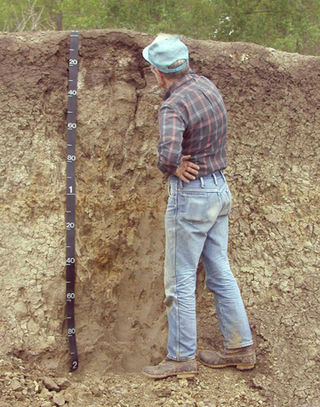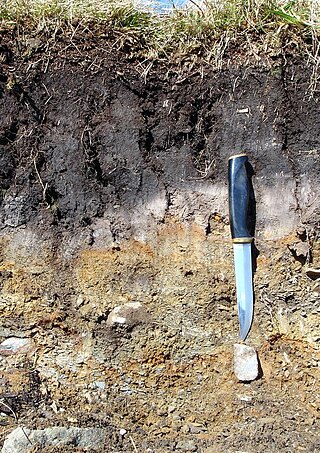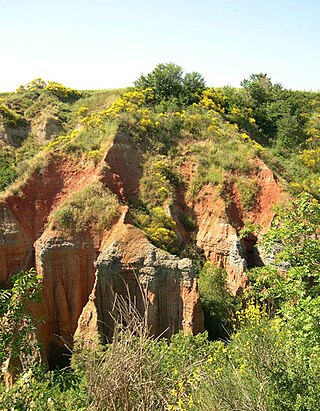Related Research Articles

Soil science is the study of soil as a natural resource on the surface of the Earth including soil formation, classification and mapping; physical, chemical, biological, and fertility properties of soils; and these properties in relation to the use and management of soils.

In geology, bedrock is solid rock that lies under loose material (regolith) within the crust of Earth or another terrestrial planet.
USDA soil taxonomy (ST) developed by the United States Department of Agriculture and the National Cooperative Soil Survey provides an elaborate classification of soil types according to several parameters and in several levels: Order, Suborder, Great Group, Subgroup, Family, and Series. The classification was originally developed by Guy Donald Smith, former director of the U.S. Department of Agriculture's soil survey investigations.

Soil classification deals with the systematic categorization of soils based on distinguishing characteristics as well as criteria that dictate choices in use.

In soil science, podzols are the typical soils of coniferous or boreal forests and also the typical soils of eucalypt forests and heathlands in southern Australia. In Western Europe, podzols develop on heathland, which is often a construct of human interference through grazing and burning. In some British moorlands with podzolic soils, cambisols are preserved under Bronze Age barrows.

Gelisols are an order in USDA soil taxonomy. They are soils of very cold climates which are defined as containing permafrost within two meters of the soil surface. The word "Gelisol" comes from the Latin gelare meaning "to freeze", a reference to the process of cryoturbation that occurs from the alternating thawing and freezing characteristic of Gelisols.
A soil horizon is a layer parallel to the soil surface whose physical, chemical and biological characteristics differ from the layers above and beneath. Horizons are defined in many cases by obvious physical features, mainly colour and texture. These may be described both in absolute terms and in terms relative to the surrounding material, i.e. 'coarser' or 'sandier' than the horizons above and below.

In the geosciences, paleosol is an ancient soil that formed in the past. The precise definition of the term in geology and paleontology is slightly different from its use in soil science.
In USDA soil taxonomy, a Psamment is defined as an Entisol which consists basically of unconsolidated sand deposits, often found in shifting sand dunes but also in areas of very coarse-textured parent material subject to millions of years of weathering. This latter case is characteristic of the Guiana Highlands of northern South America. A Psamment has no distinct soil horizons, and must consist entirely of material of loamy sand or coarser in texture. In the World Reference Base for Soil Resources (WRB), most Psamments belong to the Arenosols. However, Psamments of fluviatile, lacustrine or marine origin belong to the Fluvisols.
An Acrisol is a Reference Soil Group of the World Reference Base for Soil Resources (WRB). It has a clay-rich subsoil and is associated with humid, tropical climates, such as those found in Brazil, and often supports forested areas. In the USDA soil taxonomy, Acrisols correspond to the Humult, Udult and Ustult suborders of the Ultisols and also to Oxisols with a kandic horizon and to some Alfisols. The Acrisols low fertility and toxic amounts of aluminium pose limitations to its agricultural use, favouring in many places its use for silviculture, low intensity pasture and protected areas. Crops that can be successfully cultivated, if climate allows, include tea, rubber tree, oil palm, coffee and sugar cane.

Soil morphology is the branch of soil science dedicated to the technical description of soil, particularly physical properties including texture, color, structure, and consistence. Morphological evaluations of soil are typically performed in the field on a soil profile containing multiple horizons.
Plinthite is an iron-rich, humus-poor mixture of clay with quartz and other minerals.

Soil color is often the most visually apparent property of soil. While color itself does not influence the behavior or practical use of soils, it does indicate important information about the soil organic matter content, mineralogy, moisture, and drainage.

The solum in soil science consists of the surface and subsoil layers that have undergone the same soil forming conditions. The base of the solum is the relatively unweathered parent material.
A duripan is a diagnostic soil horizon of the USDA soil taxonomy that is cemented by illuvial silica into a subsurface hardpan. Similar to a fragipan, Petrocalcic Horizon and petrogypsic horizon, it is firmly cemented and restricts soil management. In soil descriptions, they are most often denoted by the symbol Bqm. The closest equivalent in the Canadian system of soil classification is called a duric horizon, although it does not mean exactly the same thing as a duripan in the United States. They form almost exclusively in arid or Mediterranean climates, and can be as hard as concrete, which makes plowing very difficult or impossible. Soils that include duripans are generally used for grazing or wildlife habitat, and are seldom cultivated.

A petrocalcic horizon is a diagnostic horizon in the USDA soil taxonomy (ST) and in the World Reference Base for Soil Resources (WRB). They are formed when secondary Calcium Carbonate or other carbonates accumulate in the subsoil to the extent that the soil becomes cemented into a hardpan. Petrocalcic horizons are similar to a duripan and a petrogypsic horizon (WRB) in how they affect land-use limitations. They can occur in conjunction with duripans where the conditions are right and there are enough free carbonates in the soil. Calcium Carbonates are found in alkaline soils, which are typical of arid and semiarid climates. A common field test for the presence of carbonates is application of hydrochloric acid to the soil, which indicates by fizzing and bubbling the presence of calcium carbonates.

The geography of Iowa includes the study of bedrock, landforms, rivers, geology, paleontology and urbanisation of the U.S. state of Iowa. The state covers an area of 56,272.81 sq mi (145,746 km2).
An anthrosol in the World Reference Base for Soil Resources (WRB) is a type of soil that has been formed or heavily modified due to long-term human activity, such as from irrigation, addition of organic waste or wet-field cultivation used to create paddy fields.
A stonelayer, or soil stonelayer, or stone line, is a three-dimensional subsurface layer, or soil horizon, dominated by coarse particles (>2mm), that generally follows (mimics) the surface topography. A stonelayer occupies the basal horizon of two-layered soil biomantles. A stonelayer may be one stone thick, and thus appear in a trench or pit as a "stone line," or it may be several stones thick and appear as a "stone zone". The gravel components of stonelayers may be compositionally variable, and while many are lithic clasts, often of quartzose composition, others may be metallic nodules and concretions of iron and manganese oxides, human artifacts, snail and clam shells, precious and semi-precious stones, or some combination thereof.
The term “duplex” is used in Australia for soils with contrasting texture between soil horizons, although such soils are found in other parts of the world. Duplex soils are also termed “texture contrast soils”.
References
- Pietrasiak, Nicole (7 October 2008). "Mineralogy of a Paralithic Horizon (Well Weathered Bedrock) in the Mojave Desert". The 2008 Joint Annual Meeting.
- Soil Survey Staff (2010). "Paralithic contact". Keys to Soil Taxonomy, 2010 (11th ed.). Washington: Agriculture Department. p. 26. ISBN 9780160854279.
- Soil Survey Staff (2010). "Paralithic material". Keys to Soil Taxonomy, 2010 (11th ed.). Washington: Agriculture Department. p. 26. ISBN 9780160854279.